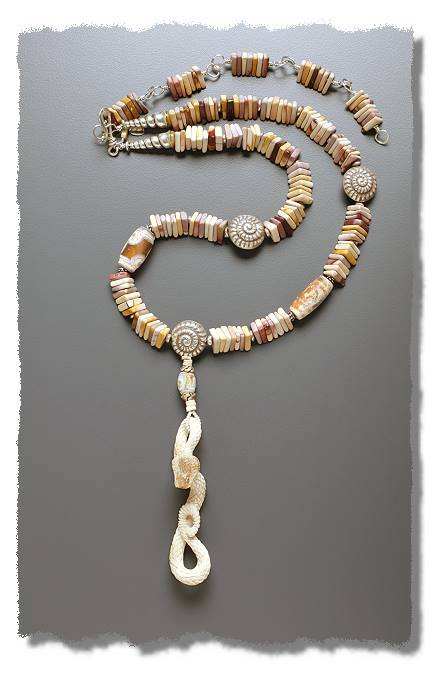This necklace features a beautifully-carved rattler of fossil woolly mammoth ivory. The carver knows rattlesnakes: the shape of the head is correct, even the wide flat plate scales on the snake's belly are accurately carved. It's also obvious that the carver has caught a snake or two. Having caught quite a few rattlers myself, I recognize the pose this snake has taken. This little fellow is hanging onto the loop and is making himself comfortable while keeping a watchful eye on his opponent.
I used to catch the rattlers around my workplace out in Sorrento Valley which at the time was relatively undeveloped. They would sometimes linger near the pathways or sometimes even get into the buildings which isn't the safest thing for either the people or the snake. I had a thin wire hook duct-taped to the end of a pole and I'd explain to the snake that I intended no harm, then slide the hook gently under it to about a third of the way down from the head (sometimes easier said than done!) and gently lift it up all in one smooth motion before the little tyke figured out what was tickling his tummy. Even a very agitated snake will immediately calm down and direct his attention to hanging on. You can then place him into a sturdy Home Depot bucket (no need to throw him in, just put him down ever so gently), put on a tight-fitting lid (with holes!), and take him to a safe place for release. (Please don't take him too far away though, local populations often have small genetic differences and it is better not to disrupt the breeding populations. It would also not be good to release him in a completely different environment than he is used to.) There is no need for drama! Please don't crush the poor thing's head under a rigid hook and hold it down while you try to pick the snake up (that's a bit silly and very stressful for the animal), and no need to strangle it with a lasso so that it whips its poor body around violently. Just keep the snake a pole's distance away from your body and be very gentle with it. And when you release the little one, for heaven's sakes, don't dump him out at your feet! PLEASE NOTE: I do NOT recommend you try this. A rattlesnake bite is potentially fatal and these animals can strike with incredible speed.
I know some people have an intense aversion to snakes. If you are one and you enjoy playing with your mind, you might want to give "tapping" a try... Hey, I'd LOVE to have a formerly snake-averse person decide they want this necklace! Tapping only takes a few minutes, it is said to gently and easily erase phobias without miserable "fatiguing the response" work. You can do it by yourself, in private. It's effective for an amazing array of issues from phobias to headaches to soothing a child or pet (you tap yourself, not the baby!). "Try it on everything!" they say. You can download instructions for free and read articles at the EFT (Emotional Freedom Technique) web site.
Whenever I meet a snake I feel blessed. I have a lot of rattler stories... if you're still reading, perhaps you'd like to hear one? OK. Here it is: Normally I hike alone. I've always been fortunate that I've never stepped on a little snake (which would annoy it rather badly) or grabbed one while bouldering. Of course I am extremely careful, but these creatures are well-adapted to our local environment and can easily disappear in plain sight. One day I was hiking in our local Cuyamaca State Park with an acquaintance from the UK. I was very pleasantly surprised that he turned out to be an excellent hiking companion who was able to blend with the environment and not disturb the wildlife. It was getting late in the day when rattlers start to come out and I mentioned I was hoping we'd see one. From his reaction I sensed that he seemed to be hoping we would not! Shortly, as we rounded a curve in the trail, I saw a snake about 50' ahead and felt overjoyed. I pointed it out quietly and my friend halted abruptly while I walked up to a respectful distance from the snake and stopped, taking time to appreciate the great beauty of this large, dark-phase Southern Pacific Rattlesnake (Crotalus oreganus helleri) stretched out across the trail. No it wasn't 12 feet long as all snake stories report, but he was a large, well-fed adult, probably somewhat over 3' long. For some reason snakes generally allow me to approach, I believe they sense my appreciation and respect. As I've noted many times, snakes are much smarter than I am and undoubtedly are extremely sensitive to energy. A frightened snake will often melt into the undergrowth and disappear instantly. An angry one will rear up with an "S" in its neck and rattle like crazy-- if that happens you should probably freeze or perhaps jump...I can never predict what my body will do when it suddenly detects that there is a rattler within striking distance, but I trust it's decision. But this lovely fellow just sat there quietly and we communed for a time. There was a field of 3' tall thin, soft grass ahead of him to my right, he could have vanished in less than a second, but he showed no inclination to move away. After a time I heard a voice from way behind me ask, "is it poisonous?" "Oh yes," I replied. A few moments later I had quite a shock: Without warning the snake streaked into the tall grass which baffled me, weren't we having a conversation? What happened next was unbelievable: he rose up on top of the grass as though it were water, on top of grass that could not possibly have supported his weight. He swam on the tops of the slender stalks for a very great distance, I'm sure it was at least 30' if not farther. And his head was up, he was looking back behind me the whole time. According to my friend, the snake shot away the instant he moved to take a step forward. The snake apparently was very aware of his presence and reacted the moment he moved. How did this creature manage to swirl over the top of the tall grass? Because I do core work, I know that when the muscles of the body are fully engaged, the body seems to become virtually weightless, it's easy to lift a person off the ground when this happens. I have experienced this dramatic effect many times. So I'm sure something of the sort enabled this fellow to pull off this exquisitely beautiful and seemingly impossible performance. I've never read anything about a snake behaving this way. Needless to say, I heeded the omen.
Some folks are concerned that the ivory in this piece might have come from an endangered species but not so. Sadly the woolly mammoth has been extinct for between 4,000 and 10,000 years. Some contend that mankind had a hand in driving it extinct. It is wise to be concerned-- poaching of the mammoth's cousin, the African elephant, has increased in recent years since the ivory ban caused prices of ivory to skyrocket, according to a recent Science News article (Nov 8, 2008). Other sources blame desperate economic conditions for fueling the trade. At the current poaching rate of about 8%, elephants will likely be close to extinction by 2020 the article asserts. So it is very wise to be careful and concerned but this little snake did not come from a living species.
Mookite is a very colorful jasper whose emotional effect Ahsian describes as helpful in understanding one's emotional and behavioral patterns. Perhaps this little snake and the mookite would assist you in transmuting some limiting pattern. It seems we all have a lot of those to work out, doesn't it?



